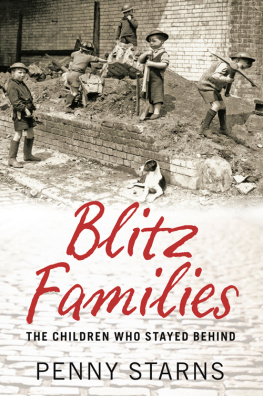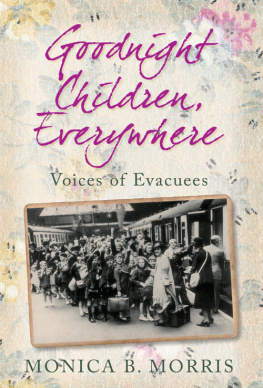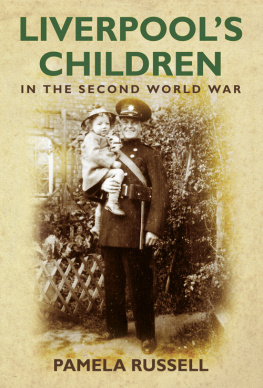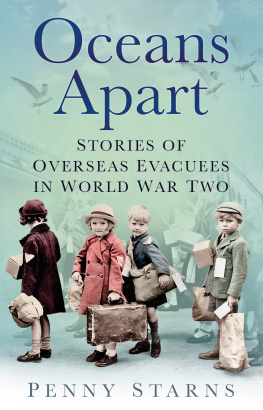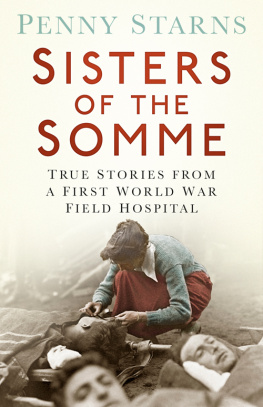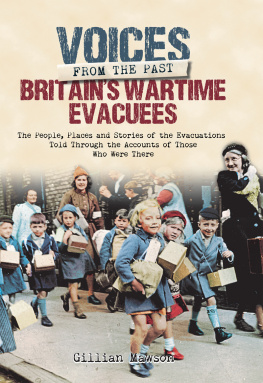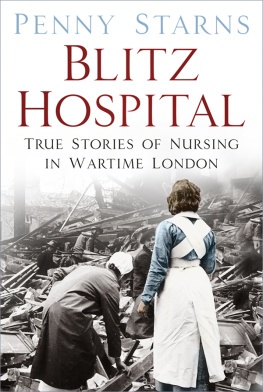
For Paul
F irst and foremost I would like to thank my editor, Sophie Bradshaw, and Abbie Wood and the design, editorial and production staff at The History Press for their excellent work. In addition, there are a great number of people without whom this book would not have been written, and I extend special thanks to Dr Andrew Brindley and his team for all of their help and support. Grateful thanks are due to the Dean, the Very Rev. Dr David Hoyle MA and the Chapter of Bristol Cathedral for allowing the inclusion of pictures of their magnificent memorial windows. I also appreciate the help extended to me by Rachel Brain, Theresa Simeone and residents of Charlton Residential Care for their wartime recollections and pertinent comments. In particular, I thank Rhoda Edmonds and David Gay for giving me so much of their time and attention. The Rev. Canon Brian Arman, his ministerial team, members of the choir and congregation of St Peters Church, Filton, have also been invaluable. Members of the congregation have generously recounted their many memories of Bristol during the Blitz, especially Iris Williams, who prompted a number of thought-provoking discussions about children and war.
My father Edward Starns has contributed enormously to the book by recalling his experiences of the London Blitz and by offering his complete support. Teachers from Birmingham, Coventry, Sheffield, Manchester, Liverpool, Plymouth, Bristol and London have provided me with mounds of evidence gleaned from their own personal experiences of working with city children during the sustained bombing raids of the Second World War. Moreover, survivors from all of these blitzed cities have kindly entrusted me with their childhood stories, which collectively have added a richness and depth to the overall text.
My friends Paul Simeone, Catherine Nile and Jo Denman have provided practical support and encouragement. I am also grateful to my brother Christopher for his previous research assistance, and to my sister Barbara Starns whose co-authored book, Keeping Children Safe , provided me with some much-needed context in terms of government child protection policies. I thank my father Edward Starns and my sons James, Michael and Lewis for their love and humour; my grandchildren for their joy and enthusiasm for life; and their mothers for enabling me to share their lives.
Sources
Much of the primary source material for this book rests on the oral history testimonies of individuals who lived through the Blitz. Most of them were children living in cities during the Second World War but others were teachers, paediatricians, social workers or parents. Collectively they have created a remarkable picture of how city children spent their war years. Further information has been obtained from all volumes of the Journal of Education (193846), The Times , Hansard House of Commons and House of Lords Parliamentary Debates for the same period. Primary source material has also been gleaned from Ministry of Health files, Board of Education (Ministry of Education after 1944) documents, and Ministry of Labour records, all of which are held at The National Archives in Kew, London. In addition, numerous files have been consulted in a variety of county record offices across the country.
Secondary sources are listed in the select bibliography at the end of this book. The main secondary works consulted however, are Children and War by A. Freud (1943), The Blitz: The British Under Attack by J. Gardiner (2010) and We Are At War: The Diaries of Five Ordinary People in Extraordinary Times by S. Garfield (2005).
Contents
M uch has been written in recent years about the children who were evacuated during the Second World War under the British governments dispersal policy. Undoubtedly, this civilian evacuation constituted the biggest social upheaval in British history, and in England alone official figures record that 673,000 unaccompanied schoolchildren, 406,000 mothers and young children and 3,000 expectant mothers were moved during the course of three days. In Scotland evacuation figures were estimated as 175,000, of which 50,000 were unaccompanied children. Journalists of the period described the initial evacuation as an exodus of biblical proportions. Subsequent waves of evacuation were more ad hoc in nature but, nonetheless, had profound and long-lasting effects on British society. However, because the historical spotlight has lingered on the children that were evacuated, a larger and more significant group of children have been overlooked. In actual fact, official figures suggest that only 47 per cent of English schoolchildren were evacuated in the initial wave, and only 38 per cent of Scottish school children. The remainder stayed steadfastly in the cities with their parents. Surprisingly, historical literature and analysis of the Second World War period has hitherto and systematically ignored this fact.
Indeed, there were vast numbers of parents who chose to ignore the dire warnings of government ministers before the war and refused to heed the calls for evacuation. Instead, they kept their children with them in cities for the duration of the war. These children endured sustained bombing raids in addition to educational and welfare problems, but new research suggests that the city children who survived the Blitz emerged from the war years emotionally, mentally and physically far healthier than their counterparts who were evacuated to the country. In fact, the ways in which children developed during the war completely baffled government ministers and for the first time in British history local authorities were forced to take on board a whole host of new ideas pertaining to child welfare. Contrary to Ministry of Health expectations, throughout the war years children were growing taller and more robust in the cities than they were in the country areas. This situation did not make sense, either to government ministers or child welfare officers. Country areas were reasonably considered to be healthy environments, with children having access to clean, fresh air and an abundance of healthy fruit and vegetables. The popular image of hearty country children helping to work the land and enjoying the fruits of their labour was also encouraged by government ministers in an effort to underpin official evacuation schemes. But children defied all predictions in terms of child development. Even when nutritional improvements to childrens diets were on a par across the length and breadth of Britain, the anomaly remained. The Ministry of Health at one stage concluded that children in the country moved around too much and, therefore, became far too active to grow! They also surmised that city children, by comparison, sat and read comics, thereby reserving their energy for essential growth. All of this was nonsense of course, but it took some time to persuade officials otherwise.
It is also important to recognise that notions of childhood changed dramatically during the war; both in terms of public perceptions and in terms of government policy. At the outbreak of war in 1939 there was a concerted effort to protect children from all mention of war; yet by 1941 children became an integral part of the war effort and nearly every family had been touched by the conflict. Conflicting policies with regard to children became the norm. The Ministry of Labour, for instance, required children to work on the land and in factories as part of the overall war effort, whereas the Board of Education argued that children needed to remain in school and focus on learning. Ministry of Health officials were thus required to tread a delicate policy-making path between the two. In addition to this problem, the latter were also up against local authority opposition for the duration of the war. In the early stages of the war local authorities often ignored the policies which emanated from Whitehall, so very few were implemented. Central government had attempted to offload responsibility for children onto local authorities, but a mixture of obstinacy and lack of resources thwarted this move. By 1941 central government was firmly back in the child policy driving seat. Astonishingly, from this time on, the Ministry of Health managed to push through a number of barriers to reform and introduce significant public health measures. Understandably, the ministers who introduced such policies as improved nutrition, the relocation of many children into the countryside and vaccination programmes, were eager to find evidence of their efficacy. They were particularly keen to find evidence that children were healthier in the country because this would endorse the validity and rationale behind their evacuation policy. The fact that children appeared to be healthier in the cities rather than the countryside defied all explanation.
Next page
